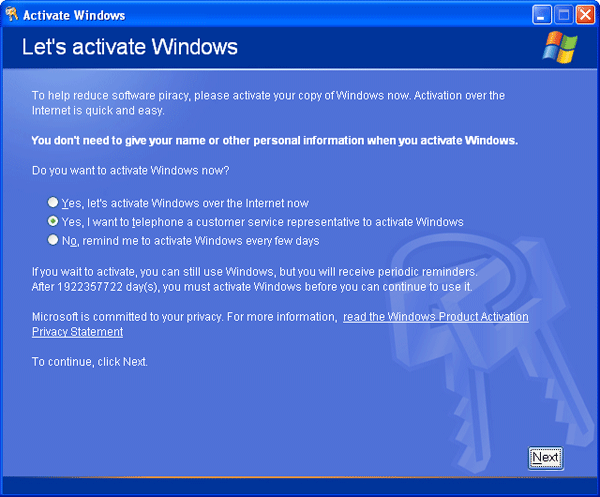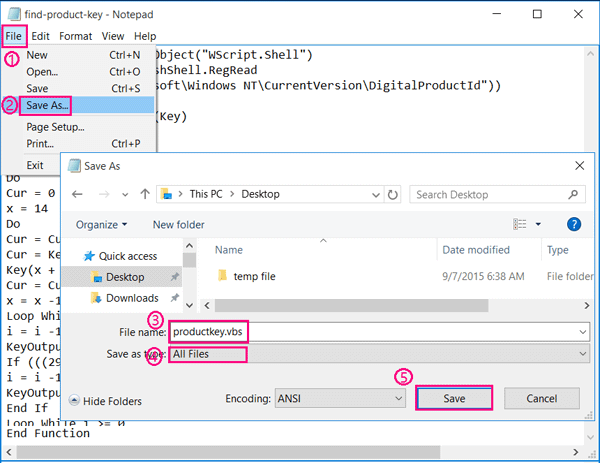What Is My Windows Registration Key
The key is sent to Microsoft when the computer searches for the latest update. Only valid license keys can update the operating system. The product identification number is shown in the Windows 'System' window.
Windows doesn’t display your PC’s serial number anywhere in its interface, and neither do popular system information tools. But you can often find a PC’s serial number with a simple command, a peek in your BIOS, or on the hardware itself.
- If your system was purchased with Microsoft Windows pre-installed and you have not reinstalled it or upgraded it yourself, a key finder may only find the generic product key that your PC manufacturer used to install Windows. This product key may not work when attempting to reinstall Windows.
- View Licensing Status and Activation ID of your Windows OS with slmgr.vbs. It is different from Registration, in the sense that, Activation is the process of ensuring that your copy of Windows is used according to the Microsoft Software License Terms, whereas registration is the process of entering information to sign up for product support, tools and tips, and other product benefits.
Run the WMIC Command
Open a Command Prompt window to get started. On Windows 10 or 8, right-click the Start button and select “Command Prompt”. On Windows 7, press Windows + R, type “cmd” into the Run dialog, and then press Enter.
At the Command Prompt, type the following command and then press Enter:
You’ll see the computer’s serial number displayed beneath the text “SerialNumber”. This command uses the Windows Management Instrumentation Command-line (WMIC) tool to pull the system’s serial number from its BIOS.
If you don’t see your PC’s serial number, blame your PC’s manufacturer. The number will only appear here if the PC manufacturer saved it to your computer’s BIOS or UEFI firmware. PC manufacturers don’t always fill in the number properly. In that case, you’ll see something like “0” or “To be filled by O.E.M.” instead of an actual serial number.
RELATED:How to Check Your Motherboard Model Number on Your Windows PC
This is also true if you built your own PC because the PC itself won’t have a serial number. However, you can look up the serial number of your motherboard and other components.
Check the BIOS
You may also be able to find the serial number in the BIOS or UEFI firmware settings screen. This technique won’t get you a serial number if the wmic command didn’t, since the command pulls the serial number from the BIOS. However, checking the BIOS could be helpful if you can’t actually sign into Windows to run the wmicOpening prayer church meeting. command.
RELATED:What Does a PC’s BIOS Do, and When Should I Use It?
Access the BIOS or UEFI firmware settings screen and look around for a “Serial Number” somewhere on a system information screen. It’ll be in a different place on different PCs, but you can usually find it somewhere on the “Main” or “System” screen.
Find the Serial Number On the PC’s Hardware, Box, or Elsewhere
If you don’t see a serial number after running the wmic command—or if you just can’t turn the PC on or don’t have access to it—there are several other places you might find the serial number:
- If you have a laptop, flip it over. On some laptops, you’ll see the number on a sticker. On others, you’ll see the number printed directly on the metal or plastic the laptop is made from. If your laptop has a removable battery, the serial number is sometimes on a sticker inside the battery compartment, under the battery.
- If you have a desktop PC, look at the back, top, or side of the case for some sort of sticker. The number may also be on a sticker inside the case, so you might have to open it up.
- If you can’t find the serial number on the PC itself, look online for instructions specific to your model. The manufacturer’s website should tell you exactly where to look.
- If you registered your PC with the manufacturer or received warranty service, the serial number should be included in the registration documentation, warranty service receipt, or email confirmation for the service.
How To Retrieve Windows 10 Product Key
- If you still have the original product box, it usually has the serial number printed on it—often on the same sticker with the bar code.
- If you purchased the PC online or in store, the serial number may be printed on the physical or email receipt you received.
And if you just can’t find your serial number at all, don’t give up hope. If you have proof of purchase, the manufacturer still may be able to help you with whatever service you need and may even be able to find out the serial number for you.
Windows 8 and 8.1 PCs no longer have a Certificate of Authenticity (CoA) sticker with their product key printed on it. This helps prevent theft — people can’t just glance at a sticker on your laptop to get your Windows product key. On the other hand, you can’t simply look at a sticker on your Windows PC when you reinstall the operating system. You’ll have to find the 25-digit product key elsewhere.
Having your product key is necessary if you want to download Windows 8 or 8.1 installation media from MicrosoftOvercome Windows 8.1 Upgrade Errors With A Legal ISO DownloadOvercome Windows 8.1 Upgrade Errors With A Legal ISO DownloadThe Windows Store upgrade doesn't work for everyone. To avoid or fix issues, perform a fresh Windows 8.1 installation using Microsoft's ISO file download. You can even use the installation media on multiple computers.Read More. Their downloads require a valid product key. It’s also useful if you want to perform a fresh install of Windows to wipe away all the bloatware that comes with a new PCHow To Remove Unwanted Crapware From Your Brand New Windows 7 SystemHow To Remove Unwanted Crapware From Your Brand New Windows 7 SystemRead More.
Embedded in UEFI Firmware
PCs that come with Windows 8, Windows 8.1, and Windows RT have an encrypted product key embedded in their UEFI firmwareWhat Is UEFI And How Does It Keep You More Secure?What Is UEFI And How Does It Keep You More Secure?Read More. When you reinstall the same version of Windows 8 or 8.1 on a PC that came with it, the product key will be automatically applied and activated. You won’t see any product key prompt — it will all happen automatically.
This only applies if you’re installing the same copy of Windows. This doesn’t apply if you install an upgrade copy, a system-builder copy, or a different edition of Windows 8Which Windows 8 Version Is For You?Which Windows 8 Version Is For You?If you’re interested in upgrading, you’ll also need to know which edition of Windows 8 is right for you. The good news is that Microsoft has simplified the different editions of Windows in Windows 8..Read More. This also won’t work if you try to install Windows 8.1 on a PC that came with Windows 8 — Windows 8.1 and Windows 8 have different product keys for some reason, so you’d need to install the original version of Windows 8 and then upgrade to Windows 8.1How To Safely Upgrade To Windows 8.1How To Safely Upgrade To Windows 8.1Are horror stories of how Windows 8.1 upgrades went horribly wrong keeping you from upgrading yourself? If you are longing to try Windows 8.1, you can now learn from other people's lessons and upgrade safely!Read More via the Windows Store.
This feature is designed to simplify things, but you may need to get at your Windows product key anyway — use a tool in the next section to view this hidden key while Windows is installed.
On a Running Windows System

The Windows product key is normally hidden and not shown anywhere in Windows’ interface. However, you can use a third-party utility to view the product key stored in Windows. You can then write down this product key and re-enter it when installing Windows. This is the only way to find the Windows product key on PCs that come with Windows 8 or 8.1 pre-installed.

You’ll need to download a third-party tool for this. We like NirSoft’s lightweight ProduKey utility, but you can also use another product-key-finding utility3 Portable Applications to Help You Find Serial Keys on Your Windows PC3 Portable Applications to Help You Find Serial Keys on Your Windows PCIf you've ever paid a chunk of change for a shareware application or subscription, you know the drill. Serial keys in the form of plain-text strings or files are pretty much the universal standard. The..Read More. Run the tool and it will display the Windows product key in use on your current Windows system — write it down so you can use it later.
In a Purchase Confirmation Email
If you purchased Windows 8 or Windows 8.1 online — maybe you grabbed that cheap $40 or $15 offerHow To Get Windows 8 For The Lowest Possible PriceHow To Get Windows 8 For The Lowest Possible PriceWhether the mixed reviews of the preview releases of Windows 8 have influenced pricing or Microsoft are simply taking a leaf out of Apple’s book isn’t quite clear, but the price of a new copy..Read More when Windows 8 was released — you’ll find your Windows 8 or 8.1 product key included in an email Microsoft sent you at the time of purchase. The product key from this email can be used when you reinstall Windows 8 or 8.1.
Here’s what our email looks like. Its subject is “Thanks for ordering Windows 8” and it was sent from Microsoft Customer Support. Your email may look a bit different if you purchased Windows 8 or 8.1 more recently.
Included in a Retail Windows Box
If you purchased a retail, boxed copy of Windows 8 or Windows 8.1, you’ll find your product key included on a card in that box. You may need to dig the box out of your closet to find your product key. Look for a card with a picture of a key on it. If you set it aside when you originally installed Windows 8, we hope you remember where you put it!
Product Key Finder For Windows 10
Visit Microsoft’s Upgrade Windows with only a product key page to download installation media for Windows 8 or 8.1 — all you need is the product key you found above.
Having trouble? Bear in mind that Windows 8 and Windows 8.1 have different product keys for some reason. If you have a Windows 8 key, you can’t install Windows 8.1 — you have to install Windows 8 and use the free upgrade to Windows 8.1. If you have a Windows 8.1 key, you can’t install Windows 8 with it. If you try either of these things, you’ll receive an “invalid product key” message. Windows 8.1 is a free upgrade to all Windows 8 users, so why Microsoft decided to make this so complicated is a mystery.
Image Credit: Kiewic on Flickr, Jon Fingas on Flickr, Frank Lindecke on Flickr